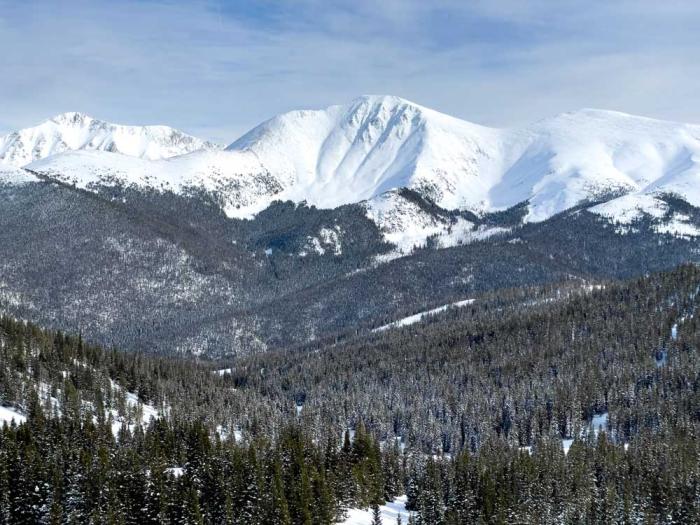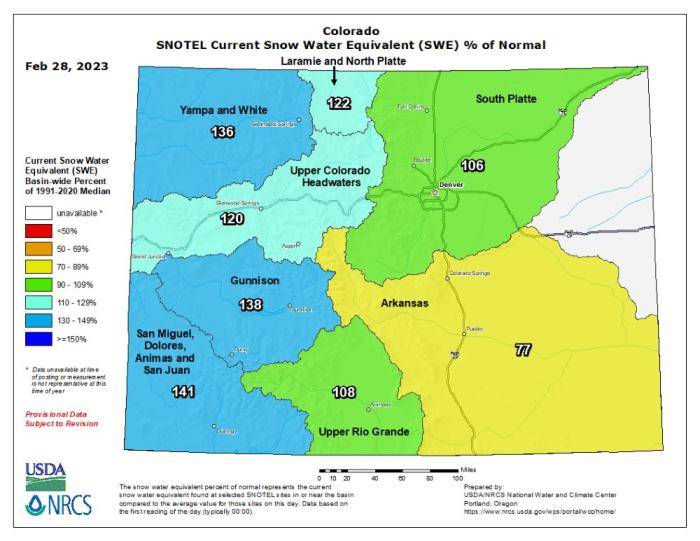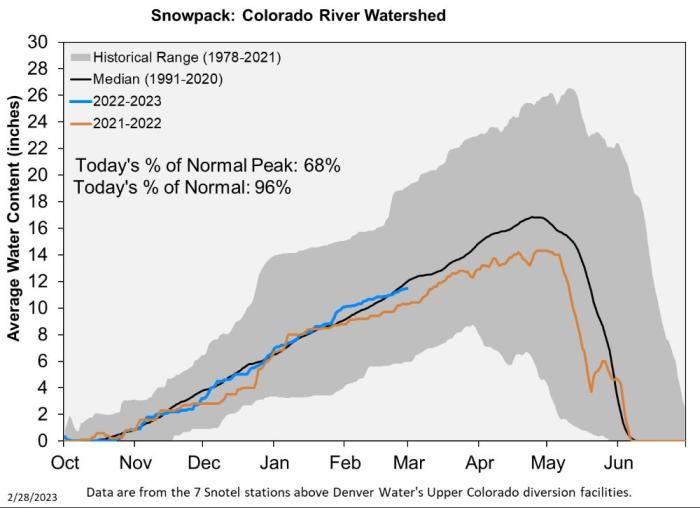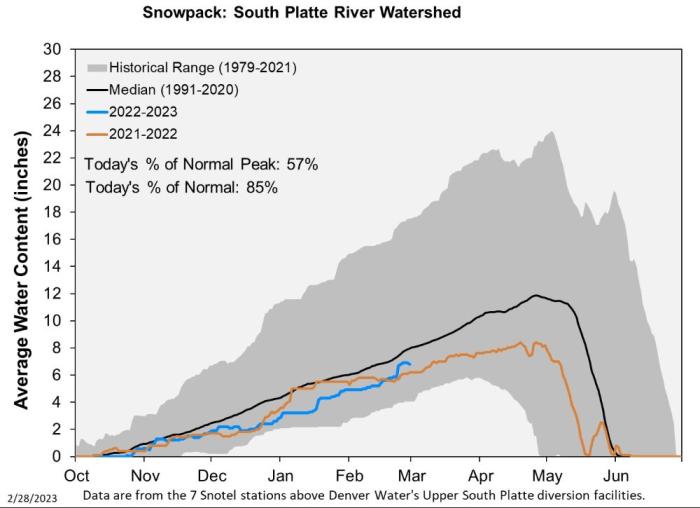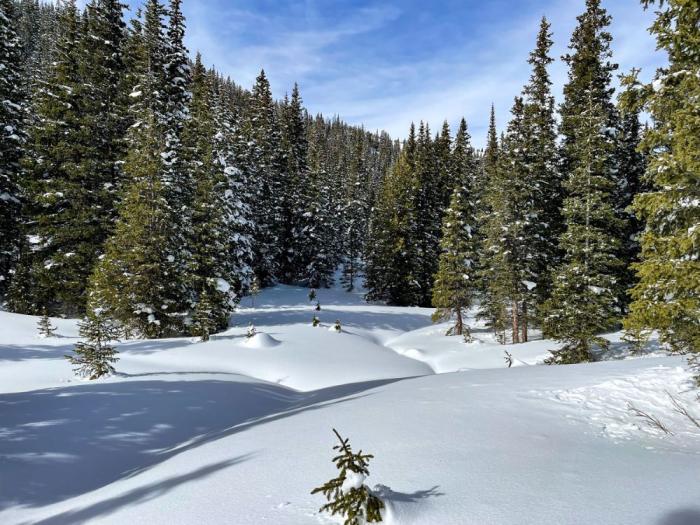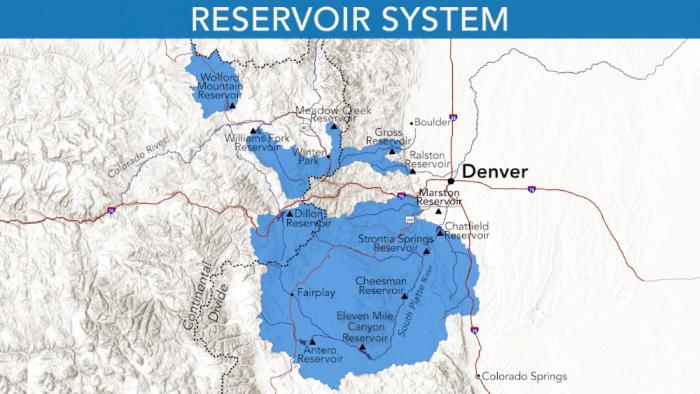Summer water outlook
With statewide snowpack above 120%, many skiers and water managers are rejoicing — but the statewide average doesn't always paint the entire picture.
For water supply, it's all about "location, location, location," explained Nathan Elder, Denver Water's manager of water supply.
"When you see the overall snowpack numbers on the news at night, keep in mind that there could be areas within the basin that could be above or below normal," he said.
"That’s why water planners always focus in on the areas directly above their reservoirs.”
For example, on Feb. 28, the entire Upper Colorado River Basin stood at 120% of normal and the entire South Platte River Basin stood at 106% of normal. However, the area of those collection systems that feed Denver Water’s storage system were only 96% and 85% of normal, respectively.
“Fortunately, those are still good snowpack numbers for us. And our snowiest months are ahead of us and weather forecasts are indicating an active pattern for March,” said Elder.
“Couple that with a reservoir storage at 82%, slightly ahead of the average for this time of year, and Denver Water is in a good position at this point in 2023.”
This year, soil moisture conditions also are looking much better compared with past years, which means the dry ground won’t absorb as much of the melting snow when it starts running down the mountains during the spring runoff.
“Looking at the state of our reservoirs, soil moisture conditions and the snowpack levels in our collection area, we’re optimistic that our reservoirs will fill during the spring runoff,” Elder said.
“We’ve been seeing consistent snow in Summit and Grand counties all winter. Usually, we see more of an on-and-off pattern, so the winter so far has been good for us.”
Aurora declares Stage 1 Drought restrictions
The city of Aurora has not been as fortunate with snowpack. Aurora officials have said they expect the city’s reservoir levels to drop to 48% of capacity by mid-April.
In an effort to protect its water supplies, the city declared a Drought Stage 1 Water Availability starting May 1, which limits lawn watering this summer to two days per week to save water.
As for Denver Water, Elder says it’s still early, but at this time the utility is not anticipating any additional watering restrictions for its customers beyond its annual summer watering rules.
Under Denver Water’s rules, there is no watering during the day between 10 a.m. and 6 p.m. and watering two days per week should be enough for most landscapes — with a third day allowed as needed only if it’s been hot and dry.
Want to know “Where does your water come from?” We’ve got you covered.
Denver Water imposed mandatory water restrictions during the 2002-04 drought, when the utility’s total reservoir storage dropped to 43% in order to keep water in the reservoirs and stretch existing water supplies.
Key elements of those early restrictions were never lifted. Rather, they were adopted by the Denver Board of Water Commissioners in 2005 as the organization’s standard approach to using water wisely and efficiently in a dry, semi-arid climate.
“We’ve been in the same situation as Aurora as recently as 2013 when we enacted two-day-per-week watering rules, so we know that water supply shortages are real here in Colorado,” said Greg Fisher, Denver Water’s manager of demand planning.
“While we’re not expecting additional restrictions this summer, we encourage our customers to be as efficient as possible with their water.”
Fisher adds that watering twice a week is usually sufficient during the summer except during extremely hot and dry weather, when grass may temporarily go dormant.
The watering rules have paid off for Denver Water, with consumption down 20% compared to before the 2002-03 drought.
Fisher encourages residents to know who their water provider is, because different communities across the metro area may have different watering rules depending on their water supply situations.
“We support Aurora’s efforts to limit water use and encourage water efficiency,” Fisher said. “While Denver Water’s rules are slightly different from Aurora's rules this year, we all share the same goal of using water wisely because water is a limited resource in the West.”
Planning for the future
Denver Water’s foresight over the past 100 years has enabled the utility to have reservoirs scattered across 4,000 square miles of Colorado’s mountains.
“You never know where the snow is going to fall, so we’re fortunate that we have multiple locations where we can capture the snowmelt that supplies our water,” Elder said.
Denver Water is currently working on a project to expand Gross Reservoir in Boulder County to add balance and resiliency to the utility’s northern collection system.
Reducing nonfunctional grass
Denver Water also is focusing on a new initiative in 2023 to reduce nonfunctional grass by 30% across the utility’s service area in the coming years.
Nonfunctional grass is defined as grass that is not used for activities, sports or community events — grass that's rarely stepped on other than when it's mowed. The push to reduce the amount of nonfunctional grass across the West is supported by water utilities from Colorado to California in an effort to help the Colorado River.
“We live in a semi-arid climate, which means we are constantly watching our water supply,” Fisher said. “Right now, we feel good about our reservoir levels and snowpack, but we will continue to help customers be more efficient so that we can weather the dry times.”


